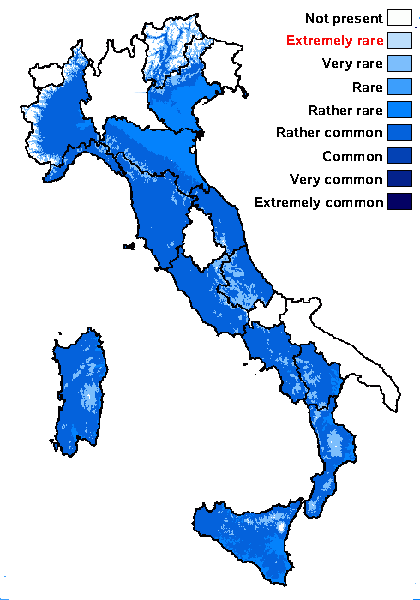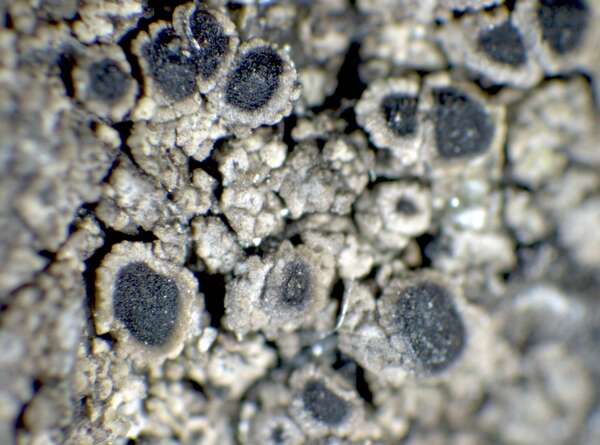Rinodina teichophila (Nyl.) Arnold
Flora, 46: 329, 1863. Basionym: Lecanora teichophila Nyl. - Flora, 46: 78, 1863.
Synonyms: Rinodina arenaria auct. non (Hepp) Th. Fr.; Rinodina colletica (Flörke) Arnold; Rinodina metabolica var. colletica Flörke; Rinodina suberumpens (Nyl.) H. Olivier
Distribution: N - VG, Ven, TAA, Piem (Isocrono & al. 2004), Emil (Nascimbene & al. 2021), Lig. C - Tosc, Marc (Nimis & Tretiach 1999), Laz, Abr (Nimis & Tretiach 1999), Sar (Matzer & Mayrhofer 1994, Rizzi & al. 2011, Cossu & al. 2015). S - Camp (Nimis & Tretuiach 2004), Bas (Nimis & Tretiach 1999), Cal (Puntillo 1996), Si (Caniglia & Grillo 2003, Grillo & Caniglia 2004).
Description: Thallus crustose, thick, rimose-areolate to areolate, smooth to granulose-verrucose, pale to dark grey or brownish. Apothecia lecanorine, immersed to adnate, up to 1 mm across, with a dark brown to black, flat to convex disc and an entire, persistent thalline margin; proper margin often visible as a ring within the thalline margin. Epithecium 10-20 µm thick, reddish brown; hymenium colourless, up to 120 µm tall, K/I+ blue; paraphyses c. 1.5 µm thick, the apical cells 3-5 µm wide, with a brown cap; hypothecium colourless. Asci 8-spored, narrowly clavate to clavate, the K/I+ blue tholus penetrated by a faintly amyloid apical cushion with parallel or diverging flanks, the wall K/I-, surrounded by a K/I+ blue outer layer, Lecanora-type. Ascospores 1-septate, brown, ellipsoid, Mischoblastia-type with tendency towards the Pachysporaria-type when mature, 18-28(-32) x 10-15(-19) µm, swelling around the septum with K, torus absent. Photobiont chlorococcoid. Spot tests: thallus and medulla K-, C-, KC-, P-, UV-. Chemistry: without lichen substances. Note: a widespread species growing on base-rich siliceous rocks, mostly on more or less calciferous sandstone), especially in nutrient-enriched situations such as on walls, tiles, brick or gravestones, mostly below the montane belt, also found in large conurbations.
Growth form: Crustose
Substrata: rocks
Photobiont: green algae other than Trentepohlia
Reproductive strategy: mainly sexual
Commonnes-rarity: (info)
Alpine belt: absent
Subalpine belt: absent
Oromediterranean belt: absent
Montane belt: very rare
Submediterranean belt: rather common
Padanian area: rather rare
Humid submediterranean belt: rather common
Humid mediterranean belt: rather common
Dry mediterranean belt: rather rare

Predictive model
Herbarium samples
Growth form: Crustose
Substrata: rocks
Photobiont: green algae other than Trentepohlia
Reproductive strategy: mainly sexual
Commonnes-rarity: (info)
Alpine belt: absent
Subalpine belt: absent
Oromediterranean belt: absent
Montane belt: very rare
Submediterranean belt: rather common
Padanian area: rather rare
Humid submediterranean belt: rather common
Humid mediterranean belt: rather common
Dry mediterranean belt: rather rare

Predictive model
| Herbarium samples |
 Index Fungorum
Index Fungorum
 GBIF
GBIF




